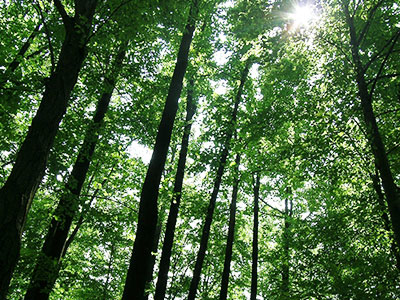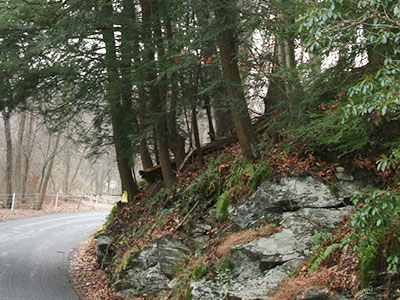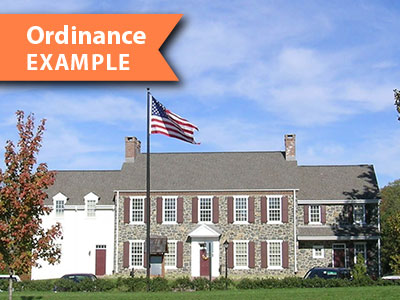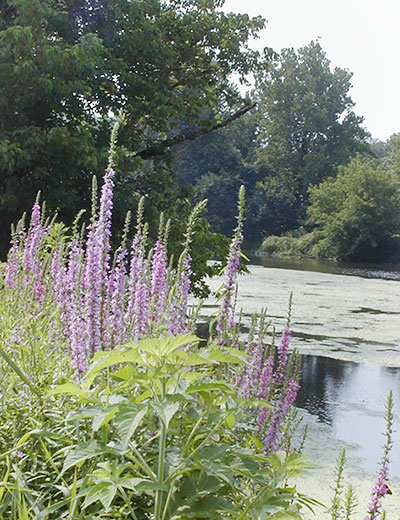Comprehensive resource protection standards are an effective way to protect complete ecosystems.
How it Works
Comprehensive natural resource protection standards ensure that resources and their functions are protected from the potential adverse impacts of land development or other disturbance. Because land, water, and biotic resources are so interrelated, comprehensive resource protection is one of the most effective ways to protect complete ecosystems. Important resources to address through protection standards include floodplains, wetlands, riparian buffers, woodlands, steep slopes and threatened and endangered species and their habitats.
Natural resources should be inventoried in the municipal comprehensive plan, which should also establish the policy basis and strategies for their protection. Protection standards are primarily located within the zoning ordinance with some related standards located in the subdivision and land development ordinance. Less frequently, the standards may be sited in a stand-alone section of a municipal code developed specifically for resource protection. Floodplains are the resource most commonly addressed in a stand-alone section, but should be clearly cross-referenced in the primary protection article.
Benefits
Environmental
Protection of natural resources reduces flooding and flood damage, improves water and air quality, reduces stormwater runoff and erosion, and protects wildlife habitat and corridors.
Open Space Preservation
Open space preservation and the creation of greenways are enhanced through the protection of natural areas.
Economic Value
As documented in the Return on Environment study, protected natural areas provide great economic value to Chester County through reduced costs for stormwater management infrastructure.
Climate Change Mitigation
Protection of natural resources, particularly trees and woodlands, helps to minimize and mitigate climate change, provide cooling effects in urban areas, and provide shade and wind protection for homes and businesses.
Effective Enforcement
Comprehensive and centrally located protection standards are the most effective means of protecting resources and avoids the possibility of inconsistent and potentially conflicting standards when they are scattered throughout the ordinance. A central location for standards also makes it easier to apply and enforce the standards.
Clear Expectations
Well organized and laid out protection standards provide municipal officials, local developers, and landowners a clearer understanding of what needs to be protected and how to protect it during the design, development review, and construction process.
Adaptable to Evolving Regulations
Centrally located protection standards allow a municipality to more easily adapt its ordinances to address emerging environmental issues and evolving regulations at the state and federal level.
Get Started
Establish Policy
Environmental protection policy should be established within the municipal comprehensive plan. The comprehensive plan should include an inventory which describes and maps the resources in the municipality. Policy recommendations for the protection of these resources, including guidance on how they will be protected through the application of ordinance standards, should be developed. The mapping of natural areas also provides guidance for determining which areas are most appropriate for growth and preservation in the future land use plan.
Develop and Adopt Ordinance Standards
A full review of the ordinance standards should be undertaken to determine the best approach for updating or expanding the resource protection standards. Depending on how strong the current standards are, amendments to fill in the gaps and add more specific protection criteria may be all that is required. Otherwise, a full update and reorganization of the protection standards may be needed.
The resource protection standards should be placed in one location in the ordinance, rather than several different sections. This approach will make it easier to enforce the provisions, avoid inconsistencies, and provide a clearer understanding of resource protection requirements for municipal officials, landowners, and developers.
Considerations
Specific Disturbance Limits
Protection standards should include specific resource disturbance limitations so that they can be effectively enforced. For example, rather than saying "minimize the impact" on woodlands or steep slopes, the standards should state the maximum percentage of disturbance permitted.
Measurable and Enforcible Standards
While the ordinance standards should be comprehensive, they should not be so complicated that they become too difficult to apply or enforce. Measurable standards that are straightforward are more effective than complex ones that cannot be properly applied. If problems with interpreting and applying the standards are encountered, those issues should be addressed in future revisions to the ordinance.
Regional Implementation
Resource protection standards work best when they are applied at the regional level. If your municipality is part of a regional planning group, consider adopting consistent regional policies for natural resource protection which can be implemented through individual ordinances. Addressing resources on a watersheds basis is another effective way to have a greater protection impact.
Standards for Each Resource
Specific standards should be created for each type of resource rather than trying to use a "one size fits all" approach. The following bullet points provide basic guidelines for the protection of individual resources. Each municipality must tailor their resource protection standards to fit their particular needs and circumstances. Links to a full model resource protection ordinance and several adopted municipal ordinances are provided under Examples.

Floodplains
- All Chester County municipal floodplain standards were updated for consistency with FEMA and new floodplain maps in 2017.
- To the maximum extent possible, do not allow new development in floodplains.
- FEMA floodplain maps are based in part on past occurrences; this mapping may not be as reliable with the more frequent flood events now being experienced.

Wetlands
- Prohibit disturbance of wetlands in the municipal standards; while Federal and state protection applies, local standards can be more comprehensive and enforcement is more easily controlled.
- Include a wetland margin buffer that limits disturbance to 20% within 50 feet of the wetlands edge.
- Mitigation or replacement of wetlands may be permitted at the Federal or state level (with proper permits), however, protecting the natural wetland is generally preferable.

Riparian buffers
- Riparian buffers are one of the most effective means to protect water quality and, therefore, one of the most important protection standards to include in the ordinance.
- Ideally buffers should be 100 feet wide, but at least 75 feet wide, from each side of stream.
- Two-tier buffers work well with the strictest disturbance limitation applied to the buffer next to the stream.
- Consider extending buffers further if the stream is located adjacent to very steep slopes.
- Tree planting within non-forested buffers can be mandated through the subdivision/land development process.
- Include regulations that establish a riparian buffer in accordance with the PA Department of Environmental Protection's Chapter 102 for PA Special Protection Waters (including any Exceptional Value or High Quality Stream). The most restrictive ordinance standard would apply when there are overlapping regulations for Special Protection Waters.

Woodlands
- Apply a maximum disturbance of 50%, but consider even less disturbance (e.g., 35%) for residential development.
- Protect trees that will remain on site during construction through a tree protection zone.
- Consider including special provisions for the protection of specimen trees (i.e., trees above a specified diameter and/or determined to be of specimen quality as defined in the ordinance).
- Woodlands protection does not apply to timber harvesting, which is dealt with as a separate agricultural use subject to the ACRE legislation. Additional information on ACRE is available from the Pennsylvania General Attorney General's ACRE webpage and CCPC's ACRE Info Sheet.

Steep slopes
- Apply specific limits to the area of steep slopes that may be disturbed. Suggested limits are no more than 30% disturbance of moderately steep slope areas (slopes with a grade of 15% to 25%) and no more than 15% disturbance of very steep slope areas (slopes with a grade of >25%).
- Greater restrictions can be applied to wooded slopes or steep slopes next to streams.
- Limitations on the types of uses and activities permitted on very steep slopes should apply.

Habitat protection
- Protecting the resources listed above also helps protect wildlife habitat.
- At a minimum require identification of Pennsylvania Natural Diversity Index (PNDI) sites or sites on the Chester County Natural Heritage Inventory (CCNHI).
- Avoid or mitigate disturbance of the PNDI and CCNHI sites; require proof that disturbance of the site cannot be avoided.

Examples
The Brandywine Creek Greenway Strategic Action Plan
The Chester County Planning Commission partnered with the Brandywine Conservancy in 2015 to develop a set of natural resource protection standards to support the Conservancy's Brandywine Creek Greenway initiative. The Natural Resource Protection standards provide a template and background information for addressing natural resource protection through municipal ordinances. The model standards are located in the Strategic Action Plan Toolkit.
Part 3 — Toolkit
Model standards start on page 327.
Additional forested riparian buffer standards that provide a higher level of protection start on page 363.

Kennett Township protects its important resources through ordinance standards which are well supported by comprehensive plan policies. The natural resource protection standards in Article XVIII of the Zoning Ordinance address floodplains, steep slopes, wetlands, wetland margins, watercourse and riparian buffers, and woodland and specimen vegetation standards. Additional resource protection standards relating to the preservation of woodlands, hedgerows, and specimen vegetation are located in the Subdivision and Land Development Ordinance.

Pocopson Township has clearly laid out protection standards supported through comprehensive plan policies. The Conservation of Natural Resource Features standards located in Section 250-87 of the Zoning Ordinance, address floodplain, steep slope, wetland, watercourse and riparian buffer protection, seasonally high water table soils, heritage trees, rare species sites, exceptional natural areas, and woodlands.

Willistown Township includes resource protection standards for vegetation protection, wetlands, floodplains, steep slopes, and riparian buffers in Chapter 73 Environmental Protection of their township code.



